Epimedium, Yin Yang Huo 淫羊藿
‘Horny Goat Weed’, EpimediumYin Yang Huo (TCM)
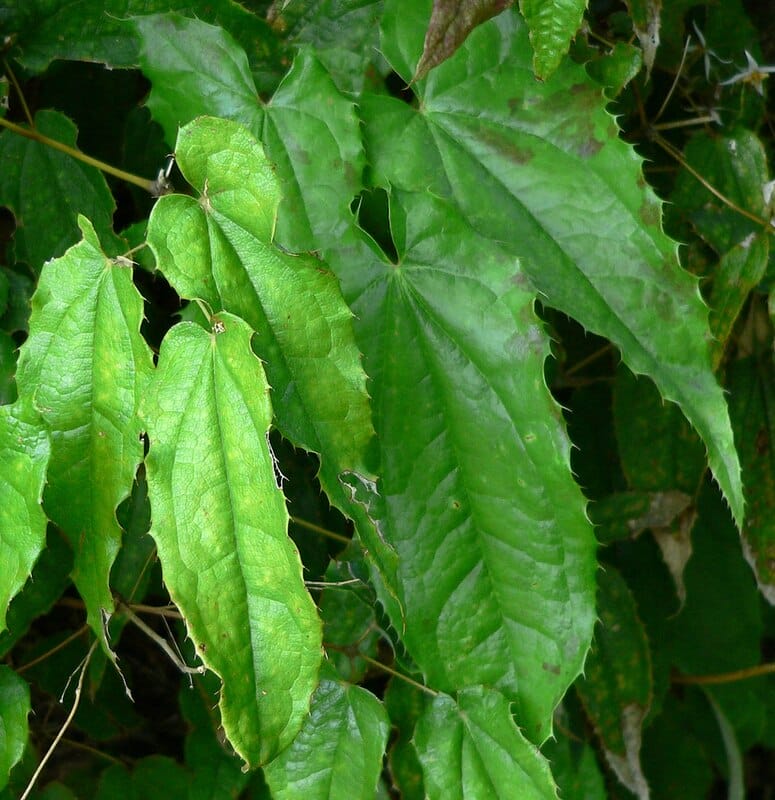 Epimedium pubescens
Epimedium pubescens(Photo by Stan Shebs) (Wikimedia) |
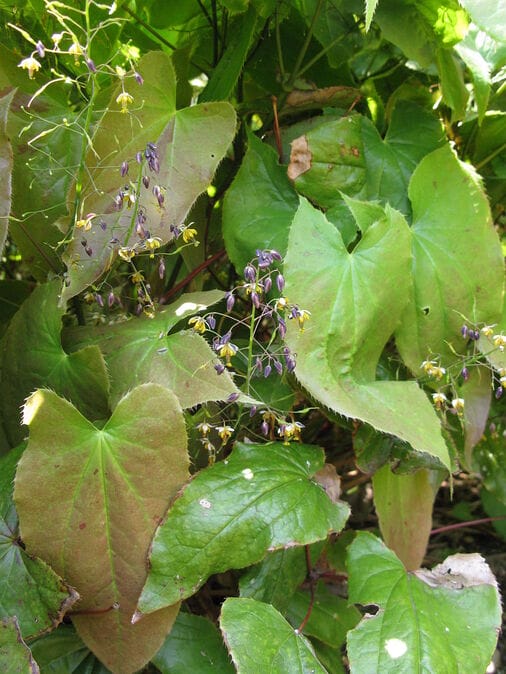 Epimedium sagittatum
Epimedium sagittatum(Photo by Qwert1234) (Wikimedia) |
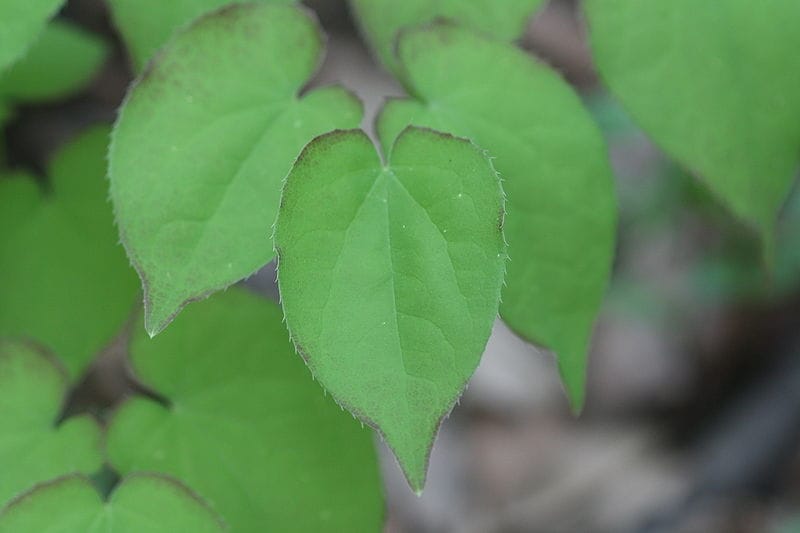
|
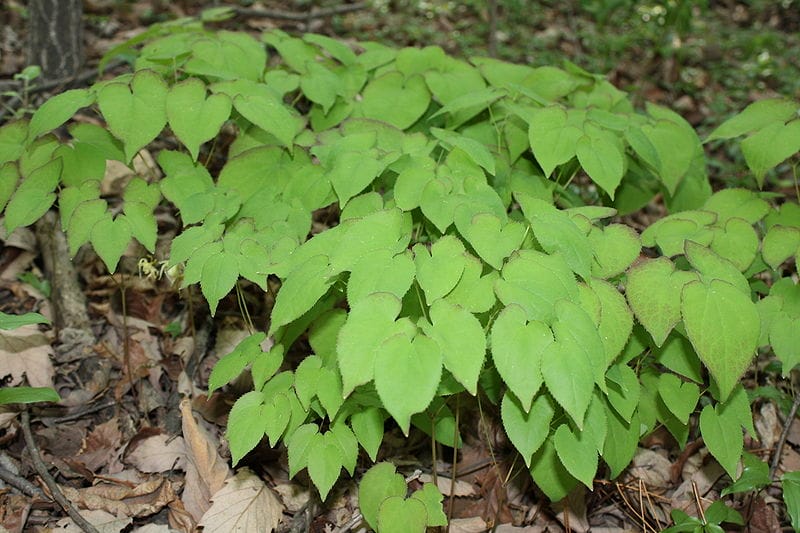
|
Photos by Dalgial
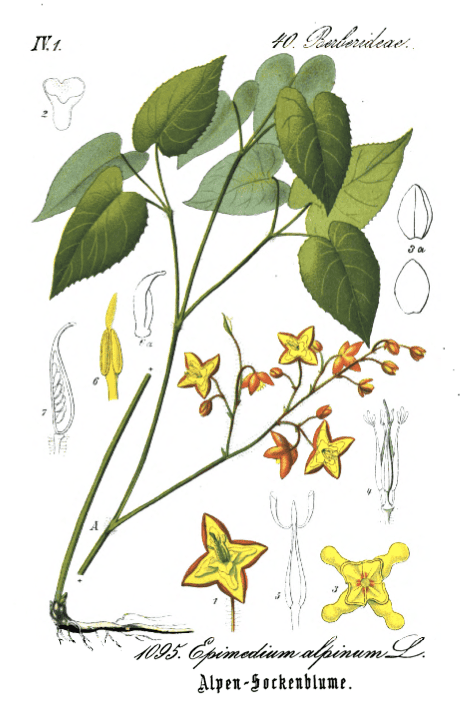 European E. alpinum is very similar in appearance to the Chinese varieties.
European E. alpinum is very similar in appearance to the Chinese varieties.Flora von Deutschland (12), Kohler, 1883
Botanical name:
Epimedium spp.
Several species are used:
- E. brevicornum
- E. sagittatum
- E. pubescens
- E. koreanum
- E. wushanensis
Parts used:
Herb
Temperature & Taste:
Warm, dry. Pungent, Sweet
Classifications:
N. Yang Tonic
Uses:
1. Strengthen Kidneys, Tonifies Yang:
-Impotence, Infertility, lower back pain, weakness of the knees
-urinary frequency, nocturnal urination
-forgetfulness, withdrawal, menopausal symptoms
-Male infertility from Yang deficiency, Female Infertility due to Yin deficiency (Da Ming)
-increases strength and invigorates Willpower. (Shen Nong Ben Cao)
-strengthens Vital Essence (Li Shi Zhen)
2. Clears Wind-Cold-Damp, Opens Obstructions:
-painful obstruction of the muscles or joints
-cramps or spasms in the hands, feet, joints
-numbness of the extremities; hemiplegia
Dose:
Decoction: 3–9 grams
Powder: 500mg–2 grams
Preparation:
1. Dry-fried Epimedium Yin Yang Huo:
Leaves can be dry-fried; this increases its Yang tonifying effect and helps expel Wind-Damp.
2. Wine-prepared Epimedium Yin Yang Huo:
Soaking the leaves in wine, then stir-frying increases the effect against Wind-Damp painful obstruction.
Some older texts stated it was stronger when prepared with wine.
3. Fat-fried Epimedium Yin Yang Huo:
An old method of treatment was to fry 600 grams of Epimedium Yin Yang Huo with 120 grams of sheep fat until the fat is exhausted. (Lei Xiao)
Comment:
There are some European varieties that are similar in appearance to the Chinese varieties. A number of different species supply the Chinese market making it more likely that the medicinal effects are endemic to the genus. The European types were occasionally used in medicine, but were generally regarded as Cool. Nevertheless, some of their functions, especially in the treatment of female complaints suggests a possible similar hormonal effect. It remains to be seen if the East and West varieties share similar functions
Main Combinations:
1. Impotence:
i. Epimedium Yin Yang Huo with Curculigo Xian Mao
ii. Epimedium Yin Yang Huo with Maca, Tribulus, Nettle root
iii. Epimedium Yin Yang Huo with Yohimbine, Rehmannia Shu Di Huang and Shilajit
iv. Epimedium Yin Yang Huo with Rehmannia Shu Di Huang and Turtle Shell Gui Ban
2. Chronic lower back pain from Kidney weakness:
i. Osteoarthritis and lower back pain, Epimedium Yin Yang Huo with Cibotium Gou Ji, Dipsacus Xu Duan, Rehmannia Shu Di Huang, Costus (Mu Xiang), Olibanum (Ru Xiang), Myrrh (Mo Yao) (as in Zhuang Gu Guan Jie Wan)
ii. Kidney weakness with Impotence and chronic Lower Back Pain, Epimedium Yin Yang Huo with Cordyceps, Eucommia Du Zhong and Cistanches Rou Cong Rong
3. Menopause, Epimedium Yin Yang Huo with Curculiginis Xian Mao, Phellodendron Huang Bai, Angelica Dang Gui (as in Er Xian Tang)
4. Paralysis and painful obstruction of the extremities, Epimedium Yin Yang Huo with Mistletoe Sang Ji Sheng
Major Formulas:
Er Xian Tang
Zan Yu Dan
Wen Yang Bu Gan Jian
Zhuang Gu Guan Jie Wan
Cautions:
1. Fire from Yin deficiency
2. Should not be used in full doses over a long period of time
3. Side effects may include dry mouth, nausea, dizziness, nose-bleeding and abdominal distention
Toxicity:
–Sub-chronic toxicity of an aqueous extract of Epimedium sagittatum (Sieb. Et Zucc.) Maxim. in rats.
Drug Interaction:
–Viagra: Herb-drug interaction of Epimedium sagittatum (Sieb. et Zucc.) maxim extract on the pharmacokinetics of sildenafil in rats.
Main Preparations used:
Of European Barrenwort (E. alpinium and others):
|
Paulus Aegineta, 7th Century ‘Epimedium, Barrenwort: its powers are moderately refrigerant, with a watery humidity. When applied in the form of a Cataplasm it preserves the Breasts in a right state. It is also said to prevent conception when taken in a draught’. (The Seven Books of Paulus Aeginata, 1847) Botanologia, Salmon, 1710: ‘… appropriated to the Joints. ‘… Parkinson says, it is without any special property, more than to keep Womens Breasts from growing over great. ‘The Virtues. IX. The Juice. Whether it is taken out of the Roots or Leaves, it is good to cool Inflammations, and is profitable to bath with in an Erysipelas. X. The Powder. It may be made of the Roots or Leaves, for of either the Virtue is the same, tho if made of the Root it is thought to be stronger; Parkinson says it is reported, that being taken |
inwardly for some time, it makes Women Barren: from whence possibly the Name might come. XI. The Cataplasm. The Leaves made into a Poultice, by beating them up with Oil, and applied to Womens Breasts, keeps them from growing great; and is good to discusses a slight Contusion.’ The Family Herbal, John Hill, 1812: ‘The people in the north give milk in which the roots have been boiled, to the females of the domestic animals when they are running after the males, and they say it has the certain effect of stopping the natural emotions. Plain sense leads these sort of people to many things. They have from this been taught to give it to young women of robust habits, subject to violent hysteric complaints, and I am assured with great success; they give the decoction of the root made strong and sweetened. ‘Twas a coarse allusion that led them to the practice, but it succeeds in cases that foil all the parade of common practice. It is said that, if they take it in too large quantity, it renders them stupid for some hours, but no ill consequence has attended this’. |
Click the Tabs above for more information on this Medicin
GENERAL / REVIEW:
–A systematic review of traditional uses, phytochemistry, pharmacology and toxicity of Epimedium koreanum Nakai.
–The genus Epimedium: an ethnopharmacological and phytochemical review.
–Chemical and pharmacological investigations of Epimedium species: a survey.
–An Evidence-Based Systematic Review of Yin Yang Huo (Epimedium spp.) by the Natural Standard Research Collaboration.
–[Advances in study on pharmacological effects of Epimedium].
–Chemical constituents from Epimedium koreanum Nakai and their chemotaxonomic significance.
–Chemical Constituents, Quality Control, and Bioactivity of Epimedii Folium (Yinyanghuo).
DRYING / PROCESSING:
–Effect of drying processes on prenylflavonoid content and antioxidant activity of Epimedium koreanum Nakai.
–Comparison of the Active Compositions between Raw and Processed Epimedium from Different Species.
–The reason leading to the increase of icariin in Herba Epimedii by heating process.
ANTI-VIRAL:
–Antiviral activity of Epimedium koreanum Nakai water extract against influenza viruses.
–Epimedium koreanum Nakai displays broad spectrum of antiviral activity in vitro and in vivo by inducing cellular antiviral state.
ANTI-INFLAMMATORY:
–Anti-inflammatory and immunoregulatory effects of icariin and icaritin.
–Anti-inflammatory neolignans from Epimedium pseudowushanese.
–Epimedium sagittatum inhibits TLR4/MD-2 mediated NF-κB signaling pathway with anti-inflammatory activity.
–Anti-Inflammatory Activity of Epimedium brevicornu Maxim Ethanol Extract.
–Inhibitory Effects of Epimedium Herb on the Inflammatory Response In Vitro and In Vivo.
–Antiinflammatory effects of Epimedium brevicornum water extract on lipopolysaccharide-activated RAW264.7 macrophages.
ANTIOXIDANT:
–Antioxidant flavonoids from Epimedium wushanense.
–Structural characterization and antioxidant activities of polysaccharides extracted from Epimedium acuminatum.
–Herba Epimedii: anti-oxidative properties and its medical implications.
IMMUNOMODULATORY:
–Anti-inflammatory and immunoregulatory effects of icariin and icaritin.
–Polysaccharides from Epimedium koreanum Nakai with immunomodulatory activity and inhibitory effect on tumor growth in LLC-bearing mice.
–The preparation optimization and immune effect of epimedium polysaccharide-propolis flavone liposome.
–Immunological modulation effects of an acid Epimedium polysaccharide on immune response in chickens.
–Structural characterization of an acidic Epimedium polysaccharide and its immune-enhancement activity.
– (E. alpinium) Immunomodulatory effects of the methanolic extract of Epimedium alpinum in vitro.
– (E. alpinium) Evaluation of the stimulatory effect of Epimedium alpinum L. methanolic extract on the immune response in vivo.
ENHANCES VACCINE:
–Liposome and epimedium polysaccharide-propolis flavone can synergistically enhance immune effect of vaccine.
–Adjuvanticity of epimedium polysaccharide-propolis flavone on inactivated vaccines against AI and ND virus.
RESISTS IMMUNOSUPPRESION:
–Astragalus polysaccharide and sulfated epimedium polysaccharide synergistically resist the immunosuppression.
ESTROGENIC:
–Standardization and evaluation of botanical mixtures: lessons from a traditional Chinese herb, Epimedium, with oestrogenic properties.
–Flavonoid glycosides isolated from Epimedium brevicornum and their estrogen biosynthesis-promoting effects.
–Icariin from Epimedium brevicornum Maxim promotes the biosynthesis of estrogen by aromatase (CYP19).
–Epimedium-derived phytoestrogen exert beneficial effect on preventing steroid-associated osteonecrosis in rabbits with inhibition of both thrombosis and lipid-deposition.
–Molecular and pharmacodynamic properties of estrogenic extracts from the traditional Chinese medicinal herb, Epimedium.
–Taxonomic, genetic, chemical and estrogenic characteristics of Epimedium species.
–Estrogenic/antiestrogenic activities of a Epimedium koreanum extract and its major components: in vitro and in vivo studies.
ANTI-ESTROGENIC:
–Estrogenic/antiestrogenic activities of a Epimedium koreanum extract and its major components: in vitro and in vivo studies.
TESTICULAR PROTECTIVE:
–Total flavonoids of Epimedium ameliorates testicular damage in streptozotocin-induced diabetic rats by suppressing inflammation and oxidative stress.
PROMOTES ERECTION / ERECTILE DYSFUNCTION:
–Effect of Epimedium brevicornum Maxim extract on elicitation of penile erection in the rat.
–[THE STUDY OF PHYSICAL – CHEMICAL AND TECHNOLOGICAL PROPERTIES OF EPIMEDIUM STRELOLIST’S DRY EXTRACT TO CREATE A SOLID DOSAGE FORM FOR THE TREATMENT OF ERECTILE DYSFUNCTION].
–Analysis of pharmacological mechanisms of Yinyanghuo as treatment of erectile dysfunction with network pharmacology-based strategy.
–Medicinal plants as a potential source of Phosphodiesterase-5 inhibitors: A review.
–Effect of lipid-based suspension of Epimedium koreanum Nakai extract on sexual behavior in rats.
–Icariin improves SHR erectile function via inhibiting eNOS uncoupling.
–Effect of icariside II and metformin on penile erectile function, glucose metabolism, reaction oxygen species, superoxide dismutase, and mitochondrial autophagy in type 2 diabetic rats with erectile dysfunction.
IMPROVES MALE SEXUAL PERFORMANCE:
–Comparison of enhanced male mice sexual function among three medicinal materials.
PREMATURE OVARIAN INSUFFICIENCY:
–A network pharmacology approach to explore active compounds and pharmacological mechanisms of epimedium for treatment of premature ovarian insufficiency.
CHRONIC OBSTRUCTIVE PULMONARY DISEASE (COPD):
–The effects of Chinese yam-epimedium mixture on respiratory function and quality of life in patients with chronic obstructive pulmonary disease.
HEART DISEASE:
–The mechanism of Epimedium in the treatment of coronary atherosclerotic heart disease based on network pharmacology, molecular docking, and in vitro studies.
–Icariin and its metabolites as potential protective phytochemicals against cardiovascular disease: From effects to molecular mechanisms.
HEART FAILURE:
–Mechanism of Epimedium intervention in heart failure based on network pharmacology and molecular docking technology.
ANTI-AGING:
–Metabonomic characterization of aging and investigation on the anti-aging effects of total flavones of Epimedium.
–[Effect of Epimedium flavonoids in retarding aging of C. elegans]
NEUROPROTECTIVE:
–Neuroprotective effects of total flavonoid fraction of the Epimedium koreanum Nakai extract on dopaminergic neurons: In vivo and in vitro.
–The neuroprotective effects of icariin on ageing, various neurological, neuropsychiatric disorders, and brain injury induced by radiation exposure.
PREVENTS COGNITIVE DEFICITS:
–Icariin, a major constituent of flavonoids from Epimedium brevicornum, protects against cognitive deficits induced by chronic brain hypoperfusion via its anti-amyloidogenic effect in rats.
NEUROPLASTICITY:
–Epimedii Herba: A Promising Herbal Medicine for Neuroplasticity.
ISCHEMIC STROKE:
–Molecular Mechanism of Epimedium Extract against Ischemic Stroke Based on Network Pharmacology and Experimental Validation.
APLASTIC ANEMIA:
–[Effect and Mechanism of Epimedium Polysaccharide on Bone Marrow Hematopoietic Function and Th17/Treg Balance in Aplastic Anemia].
ASTHMA:
–Inhibition of airway remodeling and inflammatory response by Icariin in asthma.
PULMONARY FIBROSIS:
–New anti-pulmonary fibrosis prenylflavonoid glycosides from Epimedium koreanum.
–PPARγ mediates the anti-pulmonary fibrosis effect of icaritin.
HEPATOPROTECTIVE:
–Liver protecting effects and molecular mechanisms of icariin and its metabolites.
RENOPROTECTIVE:
–Optimization of the Flavonoid Extraction Process from the Stem and Leaves of Epimedium Brevicornum and Its Effects on Cyclophosphamide-Induced Renal Injury.
RENAL FAILURE:
–Total flavonoids in Epimedium koreanum Nakai alleviated chronic renal failure via promoting AMPK activation.
DIABETES:
–Total flavonoids of Epimedium ameliorates testicular damage in streptozotocin-induced diabetic rats by suppressing inflammation and oxidative stress.
–Potential of Icariin Metabolites from Epimedium koreanum Nakai as Antidiabetic Therapeutic Agents.
–Therapeutic effects of icariin and icariside II on diabetes mellitus and its complications.
OSTEOPOROSIS:
–Preclinical studies and clinical evaluation of compounds from the genus Epimedium for osteoporosis and bone health.
–[Advances in the study on the treatment of osteoporosis with Epimedium brevicornum and its compound prescription].
–Anti-osteoporosis effect of Epimedium via an estrogen-like mechanism based on a system-level approach.
–Deciphering the molecular mechanism underlying the effects of epimedium on osteoporosis through system bioinformatic approach.
–1H NMR-based metabonomic study on the effects of Epimedium on glucocorticoid-induced osteoporosis.
–Osteoblastic proliferative activity of Epimedium brevicornum Maxim.
–Extraction, purification and anti-osteoporotic activity of a polysaccharide from Epimedium brevicornum Maxim. in vitro.
–Herba Epimedii: An Ancient Chinese Herbal Medicine in the Prevention and Treatment of Osteoporosis.
OSTEOARTHRITIS:
–Study on the Protective Effect and Mechanism of the Rhizoma Drynariae-Epimedium Formula on Osteoarthritis in Rats.
–Effect of Chinese traditional herb Epimedium grandiflorum C. Morren and its extract Icariin on osteoarthritis via suppressing NF-kappaB pathway.
RADIOPROTECTIVE:
–Radioprotective effect of epimedium on neurogenesis and cognition after acute radiation exposure.
CANCER:
–Icariin as an emerging candidate drug for anticancer treatment: Current status and perspective.
–Flavonoids from the leaves of Epimedium Koreanum Nakai and their potential cytotoxic activities.
–Polysaccharides from Epimedium koreanum Nakai with immunomodulatory activity and inhibitory effect on tumor growth in LLC-bearing mice.
–Antitumor effects of icaritin and the molecular mechanisms.
–[Comparison of antioxidative and antitumor activities of six flavonoids from Epimedium koreanum].
–[Research advances in the mechanisms of antitumor activity of Epimedium brevicornum Maxim. and its effective components].
–Anti-Cancer Properties of the Naturally Occurring Aphrodisiacs: Icariin and Its Derivatives.
BRAIN:
–Epimedium koreanum Nakai inhibits PMA-induced cancer cell migration and invasion by modulating NF-κB/MMP-9 signaling in monomorphic malignant human glioma cells.
BREAST:
–New estrogenic prenylflavone from Epimedium brevicornum inhibits the growth of breast cancer cells.
–Icariin induces apoptosis by suppressing autophagy in tamoxifen-resistant breast cancer cell line MCF-7/TAM.
LEUKEMIA / LYMPHOMA / MULTIPLE MYELOMA:
–Icaritin: A Novel Natural Candidate for Hematological Malignancies Therapy.
–Cytotoxic effects of Coptis chinensis and Epimedium sagittatum extracts and their major constituents (berberine, coptisine and icariin) on hepatoma and leukaemia cell growth.
LIVER:
–Uncovering the key pharmacodynamic material basis and possible molecular mechanism of extract of Epimedium against liver cancer through a comprehensive investigation.
–Prenylated flavonoids and dihydrophenanthrenes from the leaves of Epimedium brevicornu and their cytotoxicity against HepG2 cells.
–Cytotoxic effects of Coptis chinensis and Epimedium sagittatum extracts and their major constituents (berberine, coptisine and icariin) on hepatoma and leukaemia cell growth.
LUNG:
–Insights into the Biological Activity and Cytotoxic Mechanism of Epimedium pubigerum.
–Combined treatment with Epimedium koreanum Nakai extract and gefitinib overcomes drug resistance caused by T790M mutation in non-small cell lung cancer cells.
